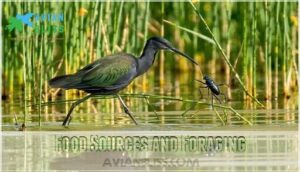This site is supported by our readers. We may earn a commission, at no cost to you, if you purchase through links.

You’ll rarely spot this secretive species as it skulks through dense marsh grasses in coastal salt marshes and inland freshwater wetlands.
These birds face a severe extinction crisis, with populations plummeting due to habitat loss and sea-level rise.
Black rails feed on aquatic beetles, small crustaceans, and wetland plant seeds while remaining hidden in thick vegetation.
Their mouse-like calls echo through marshes at dawn and dusk, but seeing one requires exceptional luck and timing.
Understanding their specific habitat requirements reveals why these remarkable survivors are struggling.
Table Of Contents
- Key Takeaways
- Black Rail Habitat
- Black Rail Diet
- Black Rail Conservation
- Black Rail Life History
- Black Rail Population
- Frequently Asked Questions (FAQs)
- How many black rails are left?
- Where is the best place to see the black rail?
- Why is the black rail endangered?
- How many black rail are left?
- What does the black rail eat?
- Where can I see the black rail?
- What sound does a Black Rail make?
- How fast can a Black Rail fly?
- Do Black Rails have any natural predators?
- Can Black Rails swim underwater?
- Conclusion
Key Takeaways
- You’re witnessing a species on the verge of extinction – Black rail populations have plummeted over 90% since the 1990s, with only 355-815 breeding pairs remaining along the Atlantic Coast, making this one of North America’s most critically endangered birds.
- You’ll need exceptional luck to spot these mouse-sized marsh ninjas – Black rails are incredibly secretive, preferring to run through dense vegetation rather than fly, and you’re most likely to hear their distinctive "kic-kic-kerr" calls at dawn and dusk rather than see them.
- You can find them in specific wetland habitats with shallow water and dense cover – They require marshes with 1-6 centimeters of water depth and thick vegetation reaching one meter or less in height, whether in coastal salt marshes or inland freshwater wetlands.
- You’re seeing climate change and habitat loss drive them toward extinction – Rising sea levels are drowning their nesting sites while development destroys nearly 50% of their wetland homes, making immediate conservation action critical for their survival.
Black Rail Habitat
You’ll find Black Rails in specific wetland habitats across North America, from California’s coastal marshes to Peru’s high-altitude wetlands around Lake Junín.
These secretive birds require dense vegetation cover with shallow water depths of 1-6 centimeters, thriving in salt marshes, brackish wetlands, and freshwater areas where plant structure matters more than species composition.
Geographic Range and Distribution
You’ll find black rails scattered across North America’s marshes in a patchy distribution that spans from Connecticut’s coast down to Central America.
Five distinct subspecies occupy specific geographic niches, with Atlantic populations concentrated in South Carolina, Florida, and Texas representing 75% of coastal birds.
California’s resident subspecies hugs the Pacific coast while isolated inland populations persist in Kansas and Colorado’s wetlands.
Their survival is threatened by significant habitat loss and human interference.
Coastal Vs. Inland Habitats
You’ll discover black rail habitat differences between coastal saltwater marshes and inland freshwater marshes create distinct challenges.
Coastal environments offer higher salinity levels that limit vegetation variation, while inland wetlands provide diverse plant communities.
Predator influence varies substantially between locations, affecting black rail survival rates and requiring targeted conservation strategies for each habitat type, which involves understanding the specific challenges of each environment to ensure effective conservation.
Vegetation and Cover Needs
When you’re searching for Black Rails, dense vegetation becomes your greatest ally and biggest challenge.
These secretive birds demand specific habitat requirements that determine their survival success.
Critical vegetation needs include:
- Dense marsh vegetation reaching heights of one meter or less
- Soil moisture levels that remain consistently saturated
- Plant structure providing overhead cover rather than specific species
- Habitat suitability depending on vegetation density over composition
Black Rails navigate through thick cattail and sedge stands like feathered ninjas, using rodent pathways beneath the canopy.
You’ll find them where vegetation structure creates the perfect hideaway.
Black Rail Diet
You’ll find Black Rails foraging strategically through dense marsh vegetation, gleaning small prey from water surfaces, soil, and plant stems using their specialized feeding techniques.
Black Rails navigate marsh vegetation like feathered ninjas, gleaning prey with surgical precision.
Their diverse diet includes aquatic beetles, spiders, snails, small crustaceans, and seeds from aquatic plants.
They collect this diet by walking methodically among marsh plants rather than diving or swimming, which is a key aspect of their diverse diet and foraging behavior, utilizing the environment with dense marsh vegetation.
Food Sources and Foraging
You’ll observe Black Rails employing diverse foraging behavior across their wetland territories.
These secretive birds practice prey gleaning while walking methodically through marsh vegetation, capturing aquatic beetles, spiders, snails, and small crustaceans from ground surfaces, shallow water, and plant stems.
Their dietary adaptations reflect seasonal diet variations based on local food availability patterns.
Aquatic Beetles and Small Crustaceans
You’ll discover that Black Rails target protein-rich aquatic beetles and small crustaceans with remarkable precision.
These invertebrates provide essential nutrients for survival and reproduction in challenging marsh environments.
Key Aquatic Prey Items:
- Aquatic beetles – High beetle nutritional value supports energy demands during breeding season
- Amphipods and copepods – Abundant crustaceans found in shallow marsh waters
- Small snails – Calcium-rich invertebrates that enhance shell and bone development
- Water mites – Microscopic prey requiring specialized foraging efficiency techniques
- Isopods – Marine crustaceans providing consistent prey abundance in coastal habitats
Diet adaptations allow Black Rails to exploit diverse invertebrate communities across varying salinity levels, maximizing foraging success in unpredictable wetland conditions.
Similarly, insects are a key food source for other bird species.
Seeds of Aquatic Plants
Beyond aquatic beetles and invertebrates, you’ll notice Black Rails supplementing their diet with seeds from marsh plants.
Bulrush seeds provide essential nutritional value, while sedge and cattail seeds offer reliable food sources.
Seed availability fluctuates seasonally, making plant diversity vital for survival.
These tiny rails actively participate in seed dispersal, inadvertently spreading aquatic vegetation throughout their wetland territories as they forage, which is crucial for their survival.
Black Rail Conservation
You’re witnessing one of conservation biology’s most urgent challenges as the Black Rail faces a critical extinction crisis across its range.
This secretive marsh dweller has experienced catastrophic population declines exceeding 90% in many areas, pushing the eastern subspecies onto the federal Threatened Species List.
While climate change and habitat destruction accelerate the species’ decline toward potential extinction.
Threats and Challenges
While adequate food sources sustain healthy populations, the Eastern black rail faces mounting pressures threatening its survival.
This federally threatened subspecies confronts multiple challenges that’ve pushed it toward extinction:
- Habitat Loss – Nearly 50% of wetlands destroyed over 200 years
- Climate Change – Sea level rise eliminating critical marsh zones
- Altered Hydrology – Drainage and channelization disrupting water regimes
- Human Disturbance – Development fragmenting remaining territories
- Oil Spills – Contaminating sensitive coastal breeding grounds
Habitat fragmentation compounds these threats, trapping birds in isolated patches.
Their distinctive mating calls are key to locating this rarely seen species.
Conservation and Research Priorities
Recovery efforts target stabilizing 300 breeding pairs by 2024 across four key regions through rapid Habitat Restoration and marsh management.
Population Monitoring tracks Eastern black rail numbers while Genetic Studies inform breeding programs.
Conservation Strategies include water control structures, prescribed burns, and invasive plant removal, often requiring specialized tools for habitat work.
Effective Threat Mitigation focuses on creating freshwater refugia safe from sea level rise, with research priorities emphasizing habitat suitability modeling and dispersal patterns.
Climate Change Impacts
Climate change delivers a devastating one-two punch to marsh birds like the black rail.
Climate change drowns nesting sites while storms flood remaining habitat, delivering a devastating double blow.
Sea level rise drowns nesting sites while storm surge floods remaining habitat.
Temperature effects alter food webs, and hydrological alterations fragment wetlands.
These climate change threats accelerate habitat loss, forcing habitat shifts that most wetland birds can’t make fast enough.
Conservation efforts now race against rising waters.
Rising temperatures also lead to shifts in migration, causing climate change threats and resulting in wetland birds being affected.
Black Rail Life History
You’ll discover that Black Rails exhibit fascinating life history traits that make them one of North America’s most enigmatic bird species.
Their secretive nature and specialized behaviors reveal complex patterns of migration, reproduction, and parental care that researchers are still working to fully understand, which showcases their highly specialized behaviors.
Migration Patterns and Behavior
You’ll find their migration patterns fascinating yet mysterious.
Their subspecies migrations vary dramatically – eastern populations undertake partial journeys while western birds remain year-round residents.
Their secretive behavior makes tracking difficult, but nocturnal vocalizations reveal movement timing.
These rail masters exhibit remarkable stealth adaptation, preferring running behavior over flight tendencies when disturbed.
Their migratory behavior follows ancient wetland corridors, with vocalization patterns serving as navigation beacons during nighttime travels through dense marsh vegetation.
Nesting Behaviors and Reproduction
Black Rail pairs establish territories during their extended breeding season from March through August, with timing varying by latitude.
You’ll find their secretive nesting behaviors fascinating as they construct well-hidden nests just inches above shallow water or saturated soil.
- Nest Construction: Females weave intricate cup-shaped structures from local marsh vegetation, creating a domed canopy with concealing overhangs and access ramps
- Clutch Size: Eastern populations typically lay 6-8 eggs, while western subspecies average 4-6 creamy white eggs spotted with brown markings
- Incubation Period: Both parents share 17-20 day incubation duties, rarely leaving their concealed nests during daylight hours.
These birds require specific nesting material products for ideal nest construction.
Precocial Chicks and Brood Rearing
Once eggs hatch, you’ll witness nature’s remarkable independence unfold as precocial chicks abandon their nest within hours.
These tiny survivors can walk, swim, and forage immediately, though parents provide essential guidance and protection during their vulnerable first weeks.
This early independence reflects precocial developmental patterns common among certain bird species.
| Development Stage | Timeline | Key Behaviors |
|---|---|---|
| Nest Departure | 24 hours | Chicks leave nest, can walk/swim |
| Parental Care | 2-3 weeks | Parents guide foraging, provide protection |
| Juvenile Plumage | 8-10 months | Adult feathers develop, independence grows |
Black Rail Population
You can’t ignore the troubling reality that Black Rail populations have plummeted across North America, with some regions experiencing over 90% declines since the 1990s.
The species now faces a critical tipping point, having lost half its population in just five decades while confronting an increasingly fragmented landscape that threatens its survival.
Population Decline and Current Status
Devastating population trends reveal the Black Rail’s conservation status has reached critical levels.
Eastern populations declined over 90% since the 1990s, with breeding range retreating 280 miles southward.
Current estimates show only 355-815 pairs remain from New Jersey through Florida.
The Endangered Species Act now protects this species, yet future projections warn of continued decline without immediate intervention and thorough threat assessment addressing habitat loss.
Habitat Fragmentation and Loss
Fragmentation tears apart the black rail’s world like scattered puzzle pieces.
Wetland Conversion and Agricultural Expansion slice through critical Habitat Connectivity, isolating populations in shrinking marsh islands.
Development Impacts destroy breeding grounds faster than Restoration Efforts can rebuild them.
Climate change impacts further exacerbate the issue.
You’ll witness habitat loss accelerating as coastal marshes vanish under concrete and crops, making habitat conservation and marsh preservation urgent priorities for species survival.
Vulnerability Assessment and Adaptation Strategies
Scientists face a critical challenge in evaluating this elusive rail’s future survival prospects. Climate models classify the species as "moderately vulnerable," though stochastic site occupancy models paint a grimmer picture for habitat resilience.
Three alarming projections demand immediate attention:
- Zero redundancy across all climate scenarios by 2100 – complete range contraction threatens population viability
- Over 90% of non-tidal sites occupied for only one year – episodic patterns reveal unstable foundations
- Atlantic Coast populations declined 90% since the 1990s – conservation prioritization becomes urgent
Climate adaptation strategies now focus on non-tidal habitat creation as sea levels rise. Conservation efforts emphasize prescribed fire management and marsh migration facilitation. Threat mitigation requires topographic refugia creation in wetlands, while conservation strategies target agricultural land assessment.
Wetland conservation partnerships accelerate habitat adaptation through collaborative management approaches.
Frequently Asked Questions (FAQs)
How many black rails are left?
Like dwindling stars vanishing from twilight skies, you’ll discover 355-815 breeding pairs remaining across the Atlantic Coast Joint Venture region, though this critically threatened subspecies faces a precarious future.
Where is the best place to see the black rail?
High salt marshes along the Atlantic Coast offer your best chances, especially in South Carolina, Georgia, and North Carolina during spring migration, though you’ll need patience and luck.
Why is the black rail endangered?
You’ll find this secretive bird endangered because habitat loss devastates their wetland homes, while sea-level rise, invasive species, and human disturbance fragment their remaining marsh sanctuaries across North America.
How many black rail are left?
Exact population numbers aren’t publicly available,
but the Atlantic Coast Joint Venture estimates 355-815 breeding pairs in that region alone.
Suggesting you’re looking at thousands rather than hundreds across all subspecies.
What does the black rail eat?
Imagine you’re observing a tiny feathered opportunist making its way through marsh shadows.
You’ll find black rails consuming aquatic beetles, spiders, snails, small crustaceans, and aquatic plant seeds through methodical ground-gleaning foraging behaviors.
Where can I see the black rail?
You’ll spot these elusive marsh dwellers in coastal salt marshes, brackish wetlands, and freshwater cattail stands, though they’re incredibly secretive and require patience to observe successfully.
What sound does a Black Rail make?
You’ll hear the Black Rail’s distinctive kic-kic-kerr call echoing through marshes, especially at night when they’re most vocal.
They also produce grr, churt, and tch sounds while moving stealthily through dense vegetation.
How fast can a Black Rail fly?
Like a shadow slipping through reeds, flight speed remains elusive in scientific literature.
You won’t find precise measurements since Black Rails prefer running through marsh vegetation over sustained flight, making aerial speed documentation nearly impossible.
Do Black Rails have any natural predators?
You’ll find these secretive birds face threats from various predators including snakes, rats, weasels, and larger birds that hunt in their dense marsh habitats.
Making their stealthy behavior essential for survival.
Can Black Rails swim underwater?
Underwater swimming isn’t part of their skill set – you’ll observe them foraging at shallow water surfaces instead.
These secretive marsh birds prefer running through dense vegetation over aquatic escapes when threatened.
Conclusion
Researchers documented a shocking discovery at Maryland’s Blackwater National Wildlife Refuge: only three black rail territories remained where dozens once thrived just two decades ago.
You’re witnessing a species on the brink of disappearing forever.
The black rail’s survival depends on immediate habitat protection and restoration efforts.
Without swift conservation action, this mouse-sized bird will join the ranks of North America’s extinct species, leaving coastal marshes forever silent.
- https://conservewildlifenj.org/?species=laterallus-jamaicensis
- https://rcngrants.org/sites/default/files/final_reports/RCN%202011-1%20CCBTR-16-09_Eastern%20Black%20Rail%20Status%20Assessment_final.pdf
- https://www.ncwildlife.gov/2025-black-rail-draft-conservation-plan/open
- https://en.wikipedia.org/wiki/Black_rail
- https://ccbbirds.org/what-we-do/research/species-of-concern/blackrail/population/












